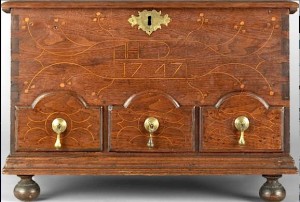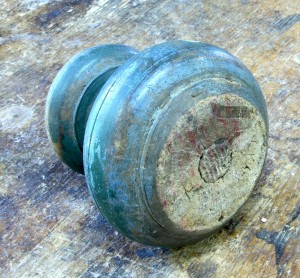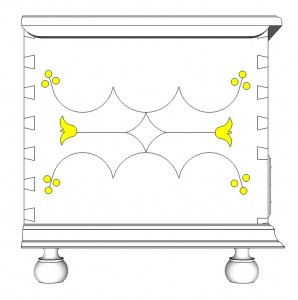We may receive a commission when you use our affiliate links. However, this does not impact our recommendations.
 My trip to Winterthur greatly impacted my knowledge of Hannah’s Inlaid Chest (what others may know as the Darlington Chest) I built for the June 2013 issue (#204). I posted a few things that would tilt the chest toward being a closer reproduction. I also promised I would point out which drawer was the imposter – the drawer front that was rebuilt by museum conservators.
My trip to Winterthur greatly impacted my knowledge of Hannah’s Inlaid Chest (what others may know as the Darlington Chest) I built for the June 2013 issue (#204). I posted a few things that would tilt the chest toward being a closer reproduction. I also promised I would point out which drawer was the imposter – the drawer front that was rebuilt by museum conservators.
The photo above is of the original chest. That’s what I had when I began the process of developing plans. I had no photos of the inside or of other decoration found on the piece. Overall, I think I did a good job in matching my piece to that in the museum, but there are differences when you get a chance to study the antique.  By the way, it’s the left-hand drawer that is the imposter. (To read more about the drawer swap, click here.)
By the way, it’s the left-hand drawer that is the imposter. (To read more about the drawer swap, click here.)
A couple other small differences include: There is a till inside the chest (similar to the till in my Pennsylvania blanket chest from August 2009, issue #177). It has a walnut lid, which is common, but it also has a walnut front. That was not always the case in period work. I fought with this idea, but in the end I felt that the inside area was too small to warrant a till, so I left it out. Oh well.
There is also what I would consider an oddity focused on the construction of the feet – I found out that this is not necessarily and oddity. The tenon on the foot is not an integral part of the foot. It is actually a dowel that is drilled completely through the foot.  While I could not take a shot of the actual foot, I do have an example of a period foot (shown at the right) that is built the same. You can see the dowel as it punches through the turned foot.
While I could not take a shot of the actual foot, I do have an example of a period foot (shown at the right) that is built the same. You can see the dowel as it punches through the turned foot.
The last significant difference would have been easily seen if I had any view but a straight-on look. The side of the antique chest has decoration on it. There is line-and-berry inlay with a couple of tulips inlaid, too. (My simple drawing of the inlay is shown in the photo.) The berries and tulips are a lighter wood that could be sumac. I assume the string work is holly. I think the front inlay work is more than enough for this small chest, but I would add the side work if I were to build Hannah’s small chest again.
If you plan to install the tulips in your version of the chest, It’s different from regular line-and-berry inlay. You may want to check out Steve Latta’s DVD “Fundamentals of Inlay: Federal Table Leg”. The installation of tulips is more like the corn husks in Steve’s leg design.
Here are some supplies and tools we find essential in our everyday work around the shop. We may receive a commission from sales referred by our links; however, we have carefully selected these products for their usefulness and quality.









I bought all the stuff for the hand inlay from Lee valley and of course you DVD. I will start the project in August.
I will reconnect with problems and as I am in NY next to CT in the Summer maybe I can catch you at a course-demo or maybe you can give a course on building the box with hand tools or router.
I love the general designs and overall looks of both Hanna’s Chest and the cellarette featured in a recent issue of PW (also in the book of MESDA pieces). It’s just a matter of personal preference but on both projects it seems to me that the inlay/stringing is way too wide. I believe that reducing the stringing width to 0.035-0.040″ wide would provide a more delicate look. I guess it’s a matter of where the piece will be placed and consistency with its eventual surroundings.
I notice (with a magnifying glass) ther small differences between the original and your reproduction, regarding the berry inlays. The berries on the front of the original chest are much smaller than the more typical berries you used, and don’t even touch each other or the ends of the stringing. I like yours better. Also, the original has even smaller berries on the drawer fronts. They are, admittedly, almost invisible, but they are there.